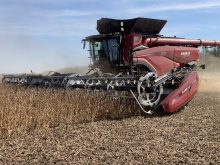WINNIPEG (MarketsFarm) — Last summer’s drought reduced the yields of many crops across the Prairies, leaving multiple supply challenges and rising prices in the aftermath.
However, western Canadian rye was largely left unscathed, which may bode well for the crop heading into 2022.
Rye production came in at 473,000 tonnes for 2021-22, according to Statistics Canada, which was a 3.1 percent decrease from the previous year. Out of all the crops grown in the country, only rye, corn and mixed grains saw higher average yields than the year before.
Read Also

Bunge’s crop mix is changing
Bunge has predominantly been a soybean processing firm, but that’s about to change after the merger with Viterra with softseed processing and grain merchandising gaining ground.
Agriculture Canada forecast rye production to be 470,000 tonnes in 2022-23 with 593,000 acres seeded, similar numbers to the previous year.
Greg Stamp, seed sales manager for Stamp Seeds in Enchant, Alta., called rye “the best crop to grow in a dry environment.” He witnessed strong sales for the cover crop last summer, especially after rains in late August and early September in southern Alberta. As feedgrain prices rose, so did the demand for rye from Alberta feedlots.
“On our dry land, durum was nine bushels per acre. Traditional fall rye was 25 bu. an acre versus a very poor wheat crop,” he said. “If you don’t have that spike in the durum market, that rye crop definitely would’ve been looking pretty good. If there would’ve been a hybrid rye, we would have seen even higher yields.”
While heavy snow cover has helped moisture conditions improve in parts of the Prairies over the winter, much of Alberta and Saskatchewan remained in a state of severe to extreme drought as of Feb. 28, according to the Canadian Drought Monitor.
The high-delivered bid for rye across the Prairies was $9.30 per bushel, as of March 11, $2.80 higher than last year, according to Prairie Ag Hotwire, a commodity price analytics agency.
Stamp added that rye grows well in situations where spring precipitation gives way to a dry summer, citing last year as an example, and can act as a weed deterrent. He also said that rye will allow growers to start their harvest, and in turn their cash flow, earlier if the weather co-operates.
“Net returns are key because you have something that can tolerate the drought. Right now, with that feed market pretty strong, even if it softens a little bit, it’s still going to be pretty competitive with all the crops that are hitting the feed market,” Stamp said.
Nathan Penner, a Manitoba-based commercialization manager for Regina’s FP Genetics, extolled the flexibility of hybrid fall rye for its uses as feed, greenfeed, silage and for grazing. The company has been selling hybrid rye varieties since 2014.
“These hybrids are more efficient in terms of water and nitrogen use, which is very important especially in these drought years. We’ve seen that they’ve shown they’re pretty resilient in dry years to produce. We had fields where the rye was going 60 bu. per acre and their wheat was going 40 or less,” Penner explained.
He believes sales will be stronger this year.
“I think what a lot of rye growers are looking for is because it’s a fall-seeded crop, it fits into their crop rotation differently than their annual species…Overall, it’s a relatively inexpensive crop to grow, but it still yields well and has profitability on the farm.”
As for how this year’s crop will go, at least in southern Alberta, Stamp is uncertain due to the area’s dryness over the past few months.
“It’s all up to the weather. Any crop is going to need a little bit of help from Mother Nature,” he said. “Rainfalls and early spring snows, because it’s extremely dry.”















